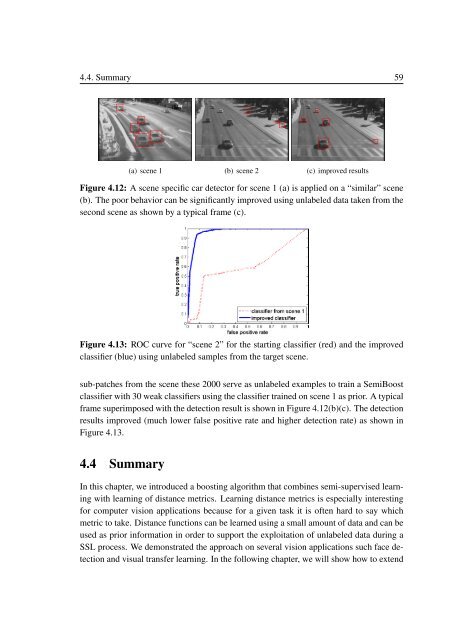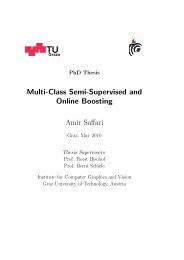PhD Thesis Semi-Supervised Ensemble Methods for Computer Vision
PhD Thesis Semi-Supervised Ensemble Methods for Computer Vision
PhD Thesis Semi-Supervised Ensemble Methods for Computer Vision
You also want an ePaper? Increase the reach of your titles
YUMPU automatically turns print PDFs into web optimized ePapers that Google loves.
4.4. Summary 59<br />
(a) scene 1 (b) scene 2 (c) improved results<br />
Figure 4.12: A scene specific car detector <strong>for</strong> scene 1 (a) is applied on a “similar” scene<br />
(b). The poor behavior can be significantly improved using unlabeled data taken from the<br />
second scene as shown by a typical frame (c).<br />
Figure 4.13: ROC curve <strong>for</strong> “scene 2” <strong>for</strong> the starting classifier (red) and the improved<br />
classifier (blue) using unlabeled samples from the target scene.<br />
sub-patches from the scene these 2000 serve as unlabeled examples to train a <strong>Semi</strong>Boost<br />
classifier with 30 weak classifiers using the classifier trained on scene 1 as prior. A typical<br />
frame superimposed with the detection result is shown in Figure 4.12(b)(c). The detection<br />
results improved (much lower false positive rate and higher detection rate) as shown in<br />
Figure 4.13.<br />
4.4 Summary<br />
In this chapter, we introduced a boosting algorithm that combines semi-supervised learning<br />
with learning of distance metrics. Learning distance metrics is especially interesting<br />
<strong>for</strong> computer vision applications because <strong>for</strong> a given task it is often hard to say which<br />
metric to take. Distance functions can be learned using a small amount of data and can be<br />
used as prior in<strong>for</strong>mation in order to support the exploitation of unlabeled data during a<br />
SSL process. We demonstrated the approach on several vision applications such face detection<br />
and visual transfer learning. In the following chapter, we will show how to extend



